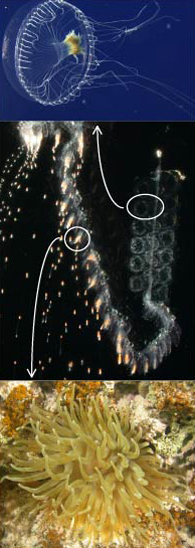
A
siphonophore, which is a colonial animal, compared with two other solitary
animals. A siphonophore nectophore, which propels the colony through the
water, is structuraly the same as a free living medusa (jelly fish), such
as the Orchistoma shown above the siphonophores. Both were derived from the same structure
in a common ancestor. The same goes for the feeding polyp of a siphonophore
and a sea anemone (shown below the siphonophore).

A colonial coral, which is made up of many polyps. All of the polyps
in this head of coral are functionally the same. The polyps and medusae of siphonophores, on the other hand, are specialized for different functions.
Siphonophores are colonial animals. This means that they are composed of many physiologically integrated zooids. Each zooid is structurally similar to other solitary animals, but the zooids are all attached to each other rather than living independently. They do not come together to form a colony, but arise by budding from the first zooid, which itself develops from a fertilized egg.
Siphonophore zooids are of two types: medusae and polyps. Solitary medusae are better known as the true jellyfish. The most familiar solitary polyps are sea anemones. There are other types of colonial animals which are made up of polyps, the most familiar being colonial corals.
Siphonophores differ from most other colonial animals in two fundamental respects. First, there is a high degree of specialization between the zooids. Zooids specialized for one function usually have well developed features to serve that function but lack the structures associated with other functions. For instance, the nectophores that propel the colony through the water (which are a type of medusa) can’t eat, and the feeding polyps can’t swim. Each is dependant on the other to do what it can’t do. Second, the specialized zooids of a siphonophore are arranged in an extremely precise pattern. This pattern is the same from colony to colony of the same species, but different between species. Siphonophores, then, have become extremely complicated organisms, just as we have, but in an entirely different way. Whereas we are made up of specialized cells that are arranged into tissues and organs, siphonophores are made up of specialized zooids precisely organized at the level of the colony. Understanding how evolution has shaped siphonophores into such complex colonial organisms may tell us quite a bit about how evolution was able to generate complex multicellular organisms, including ourselves.
Siphonophores challenge us to think about what we mean when we call something an individual, a concept that we usually think of as being quite straightforward. Is a single zooid or an entire colony the siphonophore “individual”? The answer is that you have to specify what features you are interested in before you can expect a meaningful answer. Do you mean ecologically? The entire colony functions as a single organism whether it is predator or prey. So the colony is an ecological individual. The same can be said for behavior. How about evolutionarily? There are two different components to this question. If we ask how evolution acts on siphonophores now, they are individuals. All the parts of the colony are genetically identical and the colony lives or dies as a whole (except for the eudoxids described later). So siphonophores are evolutionary individuals with respect to how natural selection shapes them today. The other way to look at evolutionary individuals is by descent. We can do this by taking a look at two animals and asking which structures descend from the same feature of a common ancestor. Just as this leads us to recognize that bat wings are modified arms, it shows that siphonophore zooids are polyps and medusae, structures that can be free living animals in other species. So this argument leads to the conclusion that the zooids of siphonophores are individuals. This is not contradictory to our previous conclusions, we are just looking at a different feature of individuality.
It should be noted that an Amoeba, which is a solitary cell, would have much the same trouble contemplating the individuality of a human. Humans function as ecological, behavioral, and evolutionary individuals. But they are made up of many cells. So is the entire human an individual, or are each of the cells individuals? We are in the same conundrum as the Ameoba because individuality has arisen multiple times in evolution, often subsuming units that are (or were, depending on how you look at it) themselves individuals. Multicellular individuality has arisen at least a couple dozen times, each time altering the individuality of the cells that make up the multicellular organism. Colonial individuality has also arisen multiple times, with siphonophores being one of the most extreme cases. And the colonial individuality in many ways subsumes the individuality of the zooids that make up the colony. There may be other insightful common threads that will only come to light when we look further at the biology and origins of individuality in other contexts.

